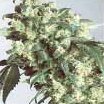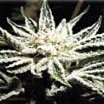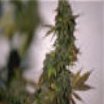 The
special properties of cannabis are derived from a group of substances unique
to the hemp plant and known collectively as cannabinoids. Some of the important
psychoactive cannabinoids include:
The
special properties of cannabis are derived from a group of substances unique
to the hemp plant and known collectively as cannabinoids. Some of the important
psychoactive cannabinoids include:| Cannabis Chemistry and Genetics |
 The
special properties of cannabis are derived from a group of substances unique
to the hemp plant and known collectively as cannabinoids. Some of the important
psychoactive cannabinoids include:
The
special properties of cannabis are derived from a group of substances unique
to the hemp plant and known collectively as cannabinoids. Some of the important
psychoactive cannabinoids include:
CBD (cannabidiol) is what gets you "stoned". It has a slightly sedative effect that relaxes the body.
CBN (cannabinol) has a stupefying effect. It is a degradation product of THC found mostly in cured buds and hashish.
THCV (tetrahydrocannabivarin) is associated with the odour of hemp.
CBC (Cannabichromene) is thought to intensify the effect of THC.
The characteristics of a particular strain of marijuana are largely determined by the amount of THC it contains and the ratio of THC to CBD. To some extent CBD acts to nullify the effects of THC. So, for instance, industrial hemp, which has no psychoactive properties, is not only very low in THC but also has a CBD to THC ration of some 5 to 1 or more.
The THC to CBD ratio is, in turn, largely determined by ...
There are two natural varieties (sub-genus) of smokeable cannabis:
Cannabis Sativa grows in hot countries like Mexico, Jamaica, Columbia, South Africa and Thailand. It's a tall (over 6 feet) leggy plant with loose flowers and it's leaves tend to be lighter coloured with many long fingers. Sativas produce a sweet, mild smoke.
Cannabis Indica grows in warm countries like Afghanistan, Pakistan, India, Lebanon, Turkey and Morocco. It's a compact (under 6 feet) plant with tight flowers and it's leaves tend to be darker coloured with short stubby fingers. Indicas produce a thick, pungent smoke.
Sativas tend to have a higher THC to CBD ratio than Indicas but Indicas tend to be more resinous and mature faster. Traditionally, Europeans tended to smoke mostly Indicas and hashish made from Indica varieties whereas Americans smoked more Sativas. Over the past few decades this situation has changed as a growing range of hybrid strains have become available.
Hybrids (cross-breeds) of Sativa and Indica take on some of the characteristics of each parent. So, such hybrid strains can be faster growing and more resinous than pure Sativas and yet have a better THC to CBD ratio than pure Indicas. Selective breeding programs have further improved these hybrids to produce a huge range of named varieties. This is an on-going process that started in America, continued in the Netherlands and is now moving to Switzerland.
The classic "Skunk" was originally bred in the USA from a combination of Latin American Sativas and Afghani Indica. Despite it's distinctive Indica-like smell, real Skunk is mostly Sativa in it's parent genetics. The more modern hybrid "Super Skunk" has a higher proportion of Indica in it's genetics.
When scanning the menu in a connoisseur coffeeshop you will likely find that indoor-grown strains with a higher proportion of Sativa command a higher price. This is because Indica strains can be grown faster and more intensively under artificial light. If coffeeshop crawling, it pays to smoke Sativas during the day and move on to the powerful Indica strains in the evening. Some common names that you're likely to find on menus include:
| <<< More Indica | More Sativa >>> | |||
|
|
 Super Skunk |
 White Widow |
 Silver Haze |
|
There are some more nice bud pics on the growroom page.
These pictures were kindly provided by Amsterdam Marijuana Seeds. You can buy seeds of all of these strains from their on-line shop at:
© Amsterdam Coffeeshop Directory: www.coffeeshopdirect.com | Contact: Lemming@coffeeshop.freeuk.com